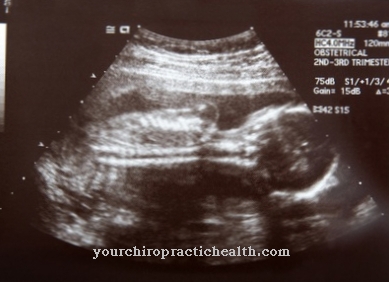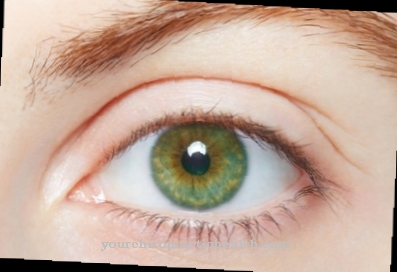As Convergence reaction on the one hand, the reflective constriction of the pupils when converging and on the other hand, the inward movement of both eyes when fixating close objects. Impairments to convergence can cause strabismus, among other things.
What is the convergence reaction?

Convergence is a specific type of opposing eye movement. Without a convergence reaction, objects could not be viewed up close. The convergence reaction is part of a neurophysiological process. This control loop also includes accommodation and the narrowing of the pupil (miosis). The complex of convergence reaction, accommodation and miosis is also known as the close-up triad.
Function & task
The convergence reaction is mediated via the third cranial nerve. In medical terminology, this is called the oculomotor nerve. Together with the trochlear nerve and the abducens nerve, it is responsible for the movements of the eyes.
The convergence reaction can be divided into two reaction steps. A contraction of the medial recti muscles is triggered via the motor core of the oculomotor nerve, the nucleus nervi oculomotorii. The medial recti muscles are muscles of the external muscles of the eye. They cause the eyeballs to turn inwards. This movement is also known as the convergence movement.
Miosis is also induced via the parasympathetic part of the ocolumotor nerve, more precisely via the accessory oculomotor nerve. Miosis is a temporary narrowing of the pupil. This is triggered by a contraction of the sphincter pupillae muscle.
In parallel to the convergence reaction, the parasympathetic part of the third cranial nerve also triggers a contraction of the ciliary muscles. The ciliary muscles are located on the outside of the radiating body (corpus ciliare) and are responsible for near accommodation.
During the convergence reaction, the turning of the eyes enables the two lines of the face to overlap. Without this reaction, an object could not be viewed from close up without creating a double image.
Convergence is what makes three-dimensional vision possible in the first place. For this vision it is necessary that the two eyeballs are directed to the same point. Only in this way can a three-dimensional image be generated from the perceived image in the central nervous system (CNS).
You can find your medication here
➔ Medicines for eye infectionsIllnesses & ailments
Impairments to the convergence reaction can lead to over- or under-function. The type of convergence disorder is assessed using the AC / A quotient. The AC / A quotient shows the ratio of accommodative convergence to accommodation provided. The ratio averages two to three degrees of convergence movement per diopter of accommodation made. The AC / A quotient can be determined using the heterophore method and the gradient method.
A squint that is triggered by an excessive convergence reaction is also known as a convergence excess. The close squint angle is very large and the remote squint angle very small or completely absent. As a rule, the eyeballs point inward when squinting. But squinting away is also one of the excesses of convergence. Here the close squint angle is less pronounced than the distant squint angle.
Altogether three forms of convergence excesses can be distinguished. In the non-accommodative convergence excess, the squint is purely motor-related. As a rule, there is no influence from accommodative components. The non-accommodative excess of convergence can be corrected through glasses. A squint operation may be necessary. The hyperkinetic accommodation excess is triggered by accommodation. The range of accommodation is normal, but the convergence performance is too high. Thus the AC / A quotient is also increased. The therapy is carried out through special glasses.
In the case of the hypo-accommodative convergence excess, the close squint angle is greatly increased, and the range of accommodation is correspondingly significantly reduced. Due to the reduced accommodation, the body tries to see sharply with an excessive convergence movement in the vicinity. The AC / A quotient is also increased here. Therapy of the hypoaccommodative convergence excess is carried out with bifocal glasses. A squint operation must not be performed under any circumstances.
A convergence spasm is an excessive convulsive movement of convergence. It is accompanied by strong accommodation and a constriction of the pupil.
In the case of convergence insufficiency, the AC / A quotient is reduced. Often this is due to a disturbance in the change in the vergence angle. The causes of convergence insufficiency are diverse. Sensorimotor disorders or neurogenic lesions can be the basis. The therapy is carried out with prism glasses, other special glasses or visual exercises. Squint operations can also be used. The best results are usually achieved with a combination of several measures.
There is also a weak convergence in endocrine orbitopathy. This is also known as the Möbius sign. Endocrine orbitopathy is a disease of the orbit (eye socket). The disease is one of the autoimmune diseases and usually occurs as part of a thyroid malfunction. The protruding eyeballs are characteristic of endocrine orbitopathy. This phenomenon is also known as exophthalmos. Connected with this protrusion of the eyes is an enlargement of the eyelid gap.
Endocrine orbitopathy is triggered by changes in the tissue behind the eyeball.Muscle, fat and connective tissue are affected by these structural and size changes. The exophthalmos together with an enlargement of the thyroid gland and palpitations form the so-called Merseburg triad. This triad of symptoms is a classic sign of Graves' disease.
The swellings and infiltrations behind the eye limit the elasticity of the eye muscles. This leads to pain when turning your gaze and restricted movement of the eyeballs. The Möbius sign is a typical symptom of endocrine orbitopathy. Further clinical signs are the Graefe sign or the Stellwag sign.



.jpg)








.jpg)



.jpg)










.jpg)
